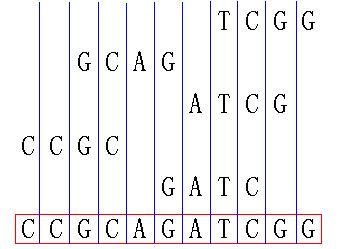poj 1699 Best Sequence
2014-07-27 14:30
274 查看
| Language:Default Best Sequence
The twenty-first century is a biology-technology developing century. One of the most attractive and challenging tasks is on the gene project, especially on gene sorting program. Recently we know that a gene is made of DNA. The nucleotide bases from which DNA is built are A(adenine), C(cytosine), G(guanine), and T(thymine). Given several segments of a gene, you are asked to make a shortest sequence from them. The sequence should use all the segments, and you cannot flip any of the segments. For example, given 'TCGG', 'GCAG', 'CCGC', 'GATC' and 'ATCG', you can slide the segments in the following way and get a sequence of length 11. It is the shortest sequence (but may be not the only one).  Input The first line is an integer T (1 <= T <= 20), which shows the number of the cases. Then T test cases follow. The first line of every test case contains an integer N (1 <= N <= 10), which represents the number of segments. The following N lines express N segments, respectively. Assuming that the length of any segment is between 1 and 20. Output For each test case, print a line containing the length of the shortest sequence that can be made from these segments. Sample Input 1 5 TCGG GCAG CCGC GATC ATCG Sample Output 11 水dp,dp[i][j]表示j为起点,i为状态的最优值 int dis[10][10];
int dp[1<<10][10];
char s[10][22];
int t,n;
inline bool cmp(char *a,int i,char *b,int j,int l){
rep(k,0,l){
if(a[i+k]!=b[j+k]) return 0;
}
return 1;
}
inline int gao(int a,int b){
if(a==b) return 0;
int l1=strlen(s[a]),l2=strlen(s[b]);
int l=min(l1,l2);
red(i,l+1,0){
if(cmp(s[a],l1-i,s[b],0,i)) return l1-i;
}
return l1;
}
int main(){
t=input();
while(t--){
n=input();
rep(i,0,n) scanf("%s",s[i]);
rep(i,0,n) rep(j,0,n){
dis[i][j]=gao(i,j);
}
clr(dp,-1);
rep(i,0,n) dp[1<<i][i]=strlen(s[i]);
int all=(1<<n);
rep(i,0,all) rep(j,0,n){
if(dp[i][j]!=-1 && (i&(1<<j))){
rep(k,0,n){
if(!(i&(1<<k))){
int nxt=(i|(1<<k));
int val=dp[i][j]+dis[k][j];
if(dp[nxt][k]==-1 || dp[nxt][k]>val) dp[nxt][k]=val;
}
}
}
}
int ans=200000;
rep(i,0,n){
if(dp[all-1][i]!=-1 && dp[all-1][i]<ans) ans=dp[all-1][i];
}
output(ans);
}
return 0;
} |
相关文章推荐
- POJ 1699 Best Sequence
- POJ 1699 Best Sequence
- POJ 1699 Best Sequence (DFS+预处理)
- poj 1699 Best Sequence(dfs+A(n,n))
- poj 1699 Best Sequence (压缩dp)
- POJ 1699 Best Sequence(DFS)
- POJ1699 Best Sequence(AC自动机+状压DP)
- poj 1699 Best Sequence (搜索技巧 剪枝 dfs)
- POJ--1699 Best Sequence(DP+dfs)
- POJ--1699 Best Sequence(DP+dfs)
- poj 1699 Best Sequence
- poj 1699 Best Sequence
- Best Sequence [POJ1699] TSP-DP
- poj 1699 Best Sequence(dfs)
- POJ 1699 Best Sequence(DFS)
- POJ 1699 Best Sequence (DFS+预处理)
- poj 1699 Best Sequence(AC自动机+状压DP)
- POJ 1699 Best Sequence
- 【POJ 1699】 Best Sequence(KMP+状压DP)
- poj 1699—Best Sequence(dfs剪枝)
